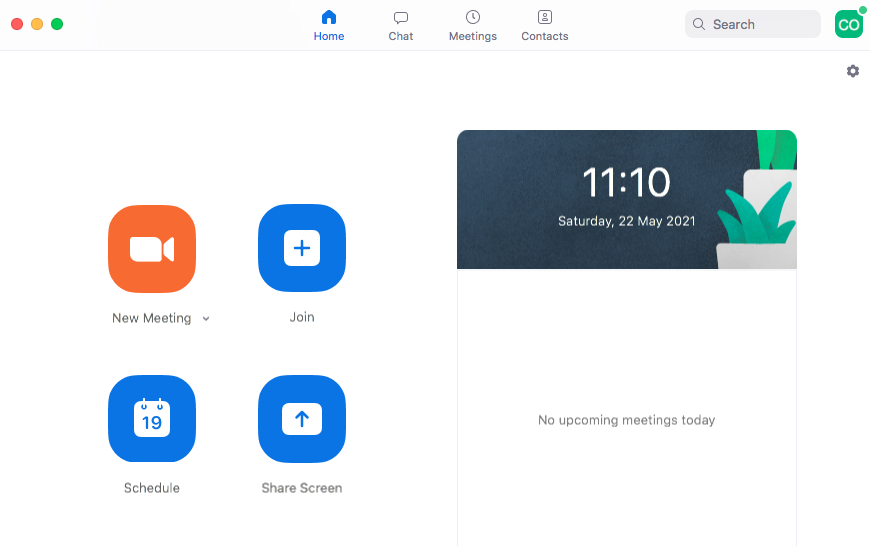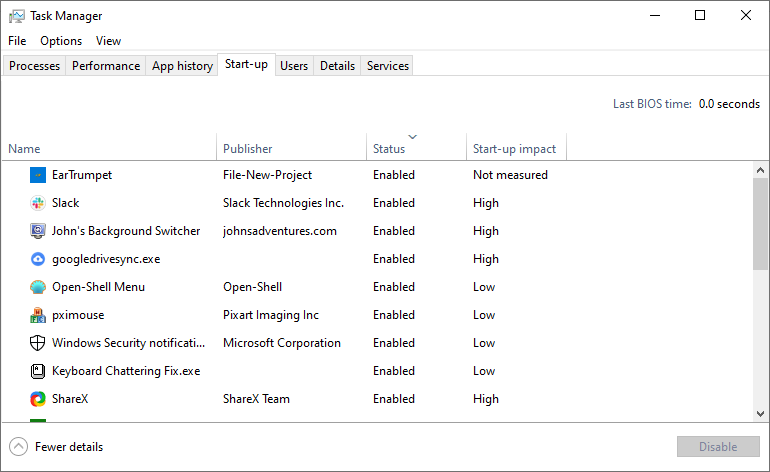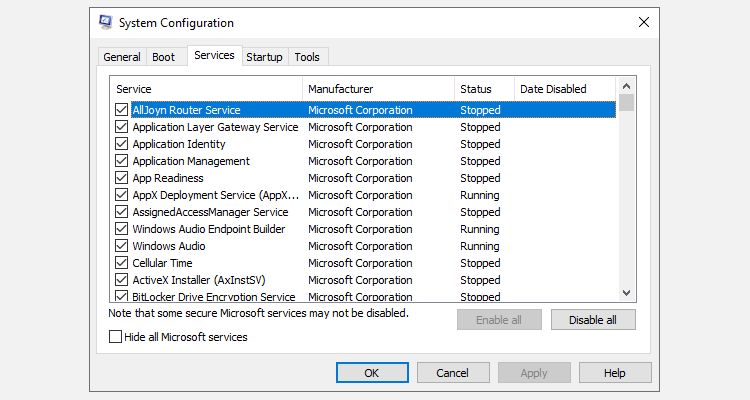Should I Disable Icloud Services On Startup
A slow PC bootup is probably the most irritating affair faced by Windows users. There tin can be many reasons for a irksome booting PC; i cause of slow bootup is too many programs and services running once Windows 10 loads.
Allow's have a closer look at some mutual startup programs that slow downwardly Windows x from booting and how you can safely disable them. In improver, we'll wait at how to manage startup programs and how you tin can determine what program yous should or shouldn't allow to commencement upwards.
Why Should You lot Disable Startup Programs?
If your computer has been booting up slowly, you probably take too many programs and services trying to start upwardly all at once. But you haven't added whatsoever programs to your startup, so how do they get at that place?
Ofttimes, programs will automatically add together themselves to the startup. That'south why it's a skillful idea to pay attending when installing software and occasionally remove bloatware. That said, non all programs that add themselves to the startup are junk.
Commonly Plant Startup Programs and Services
one. iTunes Helper
If you have an Apple device (iPod, iPhone, etc.), this process will automatically launch iTunes when the device is continued to the calculator. It is an unneeded process, as y'all can manually launch iTunes when you'd like, and it is specially unnecessary if yous don't accept an Apple device at all.
2. QuickTime
QuickTime allows yous to play and open various media files. The program is often required to view web content, specifically videos. But why does it need to "startup"? Short reply: it doesn't.
3. Zoom

Yep, we all love Zoom. Simply, there is no need for it to be a startup program when you tin can manually launch it as needed to attend meetings. Furthermore, disabling information technology at startup does non affect Zoom's updates.
4.Adobe Reader
You probably know Adobe Reader as the pop PDF reader on your computer. Although you don't demand it (and in that location are great alternative PDF readers), Adobe Reader is still the program of choice for many. Why it "needs" to automatically startup is across me, though. Uncheck.
five.Skype
Skype is an first-class video chat program—no one is arguing that. But do you demand information technology starting up and signing in as soon as you log into Windows? Probably not.
six. Google Chrome
Did y'all know that for Google Chrome to stay updated and current, you don't demand it and its other services to startup? All information technology does at startup is consume organisation resources that Windows could use for faster bootup.
7. Spotify Web Helper

Spotify is a terrific mode to observe new music, and with the new Spotify spider web player, you don't even need information technology installed. Yet, if you practise have it installed, yous might find this little application in your startup.
Information technology merely allows the Spotify desktop application to communicate with your browser. When a Spotify song is clicked somewhere on the web, it automatically opens up in the desktop awarding. Is that feature worth the added burden to your bootup fourth dimension? No.
8. CyberLink YouCam
If you have a webcam, you lot will probable accept CyberLink'due south YouCam for your software. Thus, "they" (the manufacturers) experience it should automatically startup. So what does it do when it starts up? Nil, except add unneeded processes. Uncheck.
9. Evernote Clipper
We're huge fans of Evernote, and the Web Clipper is fantastic. That said, it has always been puzzling every bit to why it gets added to the startup. You tin easily disable information technology and utilise the Web Clipper daily, if not hourly, ground, and you volition non face whatsoever bug with it not clipping correctly.
10. Microsoft Part
Microsoft Office is the about well-known function suite around. Merely what skillful does it do for yous when starting up? If you disable it, can you lot nonetheless open any files? Yes. Can you launch any of the programs manually? Yes. Are at that place any features that yous can't take advantage of? No. Allowing it to kickoff upwards is only a burden on your arrangement.
Keep in mind that this applies to any alternative role suites as well.
Managing Your Startup Programs and Services
Organization Configuration is a great local tool to apply for managing startup applications and services. You can launch it past typing MSConfig in the Outset Carte search bar and selecting the Best match.
Alternatively, pressWindows Key + Rto open the Run dialog, inputmsconfig, and press Enter.
As a Windows user, y'all will as well observe that the Startup tab in the System Configuration no longer lists the startup applications. Instead, at that place is a link pointing you to the Startup tab in the Task Director, which you can also go to by right-clicking on the Windows Taskbar or with the hotkey combination: Ctrl + Shift + Esc.

Once you view the Startup tab, you can sort the items by name, publisher, condition (enabled/disabled), and startup touch (high, medium, low).

It appears as though to forestall services from starting upwardly, you must yet uncheck them in System Configuration, as stopping them in the Task Managing director only stops them at that time, and they will get-go once again when the system reboots.
To Keep or Non to Keep
This list to a higher place is express to typical applications and services you should remove if installed on your PC. You may have more or less depending on the programs you have. For case, Steam, the pop gaming software, is some other programme that can part perfectly without needing to exist added to the system startup. There is too plenty of bloatware you lot can remove in Windows 10.
Suggestions For What You Should Permit to Start-Up
The challenge is determining which programs and services outside of the ones listed in this article should exist enabled or disabled at startup. Below are some guidelines:
- Leave alone anything associated with your antivirus (due east.1000., Avast, Avira, etc.).
- Services and applications for audio, wireless, touchpads (for laptops) shouldn't exist disabled.
- Exist cautious disabling Microsoft services – know precisely what you're doing.
- Applications and services for Intel and AMD should generally stay enabled.
- Cloud sync programs like Dropbox, SugarSync, Google Drive, etc., should startup.
- Anything you desire to run automatically, without your permission (Recollect: "set and forget").
Are you curious about some programs that you should allow startup, aside from the types mentioned to a higher place? Keep in mind that yous want to accept as lilliputian as possible starting up, simply you also desire to take advantage of your calculator'due south ability to launch various programs without the demand to practice information technology manually.
Websites to Help Evaluate a Program
Due to constant changes in technology, one cannot rely on a unmarried article to determine what all non-essential startup items are. Even with given guidelines, sometimes a service or program is unrecognizable or vague in the description. For those, you need to plow to websites with a database of applications and services that prove what they are, who makes them, and whether they're necessary for your estimator to run correctly. Below is a list of recommended websites:
- Should I Block Information technology?
- Glarysoft Startup Applications
- Pacman's Portal Windows Startup Programs Database
- PC Pitstop Process Library
Speed Up Your PC By Disabling Startup Programs
It'south essential to understand that in that location is a risk in removing services and programs from the startup. Although many are not needed, many others are. Should y'all remove something critical to your computer starting up, there tin can exist negative consequences. We cannot reiterate enough the importance of knowing exactly what to look upon terminating each service and program from starting.
Should I Disable Icloud Services On Startup,
Source: https://www.makeuseof.com/tag/make-windows-start-faster-10-non-essential-startup-items-can-safely-remove/
Posted by: williamsonlikeethimp.blogspot.com


0 Response to "Should I Disable Icloud Services On Startup"
Post a Comment